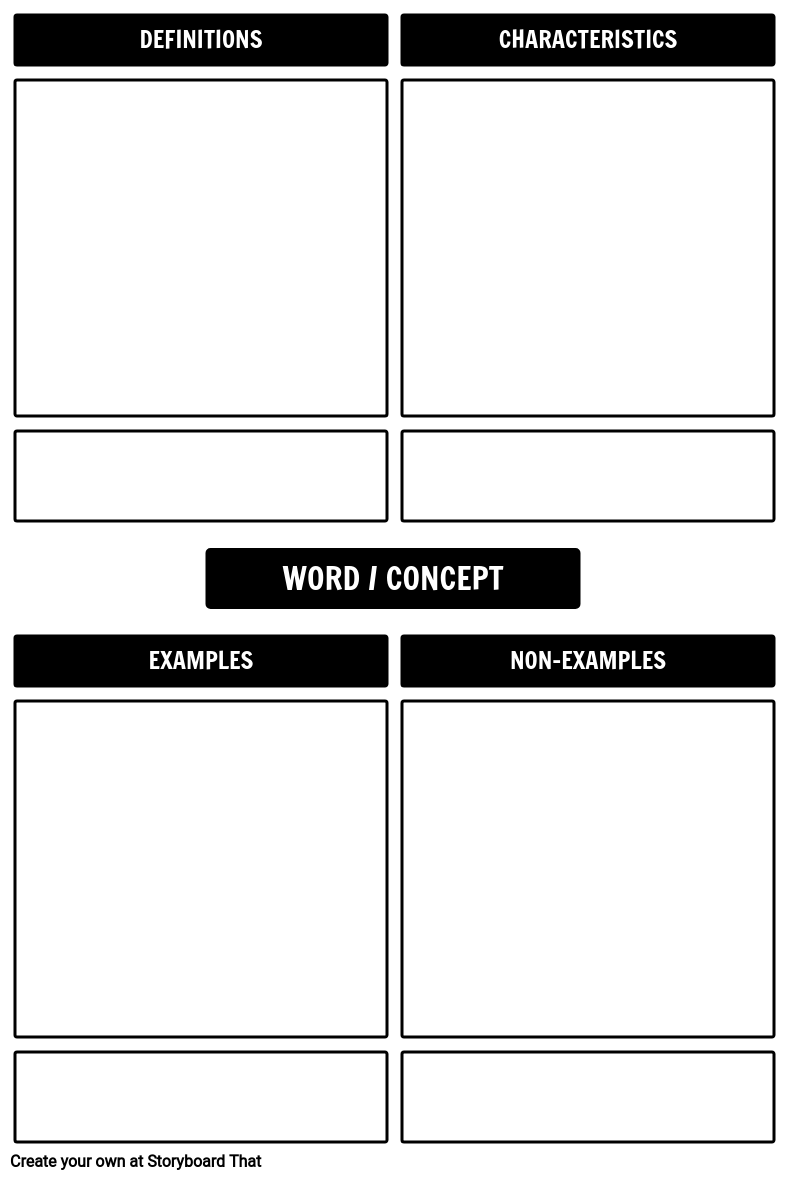Activity Overview
Uncovering the motivations of a protagonist and understanding different archetypes in fiction is an important part of literary appreciation. In The Catcher in the Rye, Holden Caulfield is considered an anti-hero. Students can create Storyboards with cells tracking the protagonist's actions, and find support that categorizes him as an anti-hero.
For front-loading terms and a lesson plan, see our article on anti-heroes.
An anti-hero, by definition, is a central character who lacks conventional heroic attributes. Some even display qualities that are almost more in line with villains. Traits like conceitedness, immorality, rebellion, and dishonesty signal that the author does not intend the audience to admire the protagonist. In the sample board below, the Frayer Model is used to reveal how Holden fits this archetype.
Anti-hero Definition: a central character in a story, movie, or drama who lacks conventional heroic attributes such as idealism, moral goodness, and altruism.
Characteristics: Holden is an anti-hero because he is a perpetual liar, he frequently judges and finds fault with others, and he fails to follow through with any plans.
Examples: Holden meets three girls in a bar and dances with them, but he thinks they’re all morons. He eventually tells one girl that he has just seen Gary Cooper, the movie star, to mess with her because he can’t stand her. When she tells the other girls she even caught a glimpse of him, Holden gets a good laugh.
Non-Examples: Phoebe is the opposite of Holden. She is sweet, innocent, and genuinely concerned for Holden. When she finds out he’s failed out of school, she’s afraid of the punishment he’ll get from their father. When he tells her he’s hitchhiking out West, she tries to come along, and follows him to the zoo afterwards, even though she’s upset.
Template and Class Instructions
(These instructions are completely customizable. After clicking "Copy Activity", update the instructions on the Edit Tab of the assignment.)
Student Instructions
Create a storyboard that shows how Holden Caulfield can be considered an antihero.
- Identify events of the story or characteristics of Holden that fit into attributes of an antihero.
- Illustrate examples for Definition, Characteristics, Examples and Non-Examples.
- Write a short description below each cell that specifically relates Holden Caulfield as an antihero.
Lesson Plan Reference
- [ELA-Literacy/W/9-10/1] Write arguments to support claims in an analysis of substantive topics or texts, using valid reasoning and relevant and sufficient evidence
- [ELA-Literacy/SL/11-12/4] Present information, findings, and supporting evidence, conveying a clear and distinct perspective, such that listeners can follow the line of reasoning, alternative or opposing perspectives are addressed, and the organization, development, substance, and style are appropriate to purpose, audience, and a range of formal and informal tasks
- [ELA-Literacy/SL/11-12/5] Make strategic use of digital media (e.g., textual, graphical, audio, visual, and interactive elements) in presentations to enhance understanding of findings, reasoning, and evidence and to add interest
Rubric
(You can also create your own on Quick Rubric.)
| Proficient 25 Points | Emerging 21 Points | Beginning 17 Points | Try Again 13 Points | |
|---|---|---|---|---|
| Character Traits | Character is thoroughly described and accurately portrayed as an antihero using multiple adjectives. | Character description is clear but lacks details and has limited descriptive words. | Character description lacks clarity and/or detail, and may not be completely reflective of an antihero. | Character chosen does not fit the description of an antihero, or character chosen does not have enough information to score. |
| Influence on Story | Character is shown to have significant influence on respective story and other characters. | Student states why the character is appealing to them, but may need more solid information on why this is so. | Student either does not explain character appeal, or does not provide sufficient details. | Character’s influence is incorrectly explained, or project is not complete enough to score. |
| Use of Quotes | Multiple quotes have been used, are representative of an antihero, and are organized efficiently. | Quotes were used, but do not produce strong proof that the character is an antihero. | One quote is used, and does not efficiently or acceptably convey the character’s traits. | Incorrect quote was used, or no quote was used. |
| Presentation | Maximum effort is displayed, storyboard is exemplary, trivial or no errors are noted | Student shows decent effort in the creation of the storyboard, editing was performed, and few errors are noted. | Student produced a satisfactory story board, but it may lack visual appeal, contain errors, or has missing parts. | Presentation needs improvement, is incomplete, or poor effort was put forth. |
More Storyboard That Activities
Catcher in the Rye, The
This Activity is Part of Many Teacher Guides
© 2024 - Clever Prototypes, LLC - All rights reserved.
StoryboardThat is a trademark of Clever Prototypes, LLC, and Registered in U.S. Patent and Trademark Office










